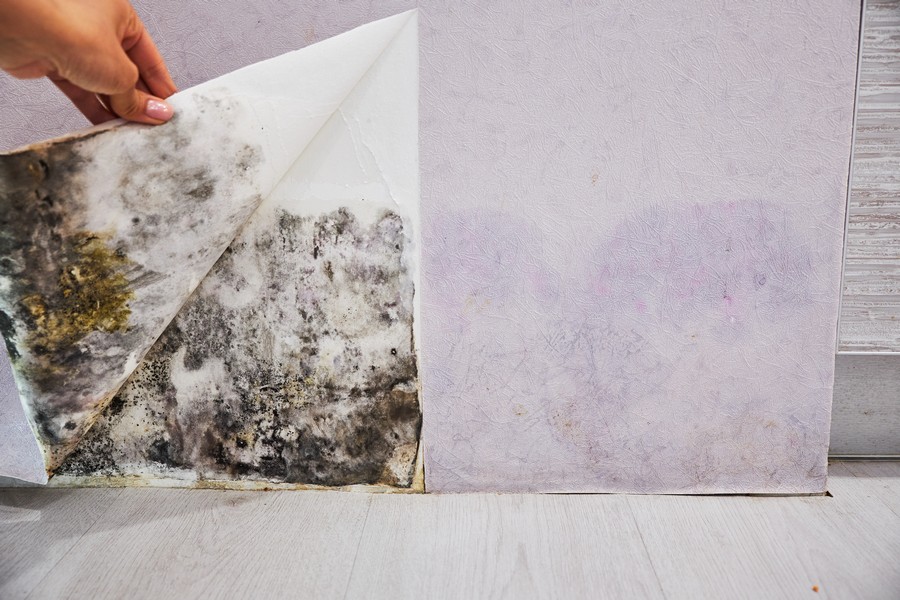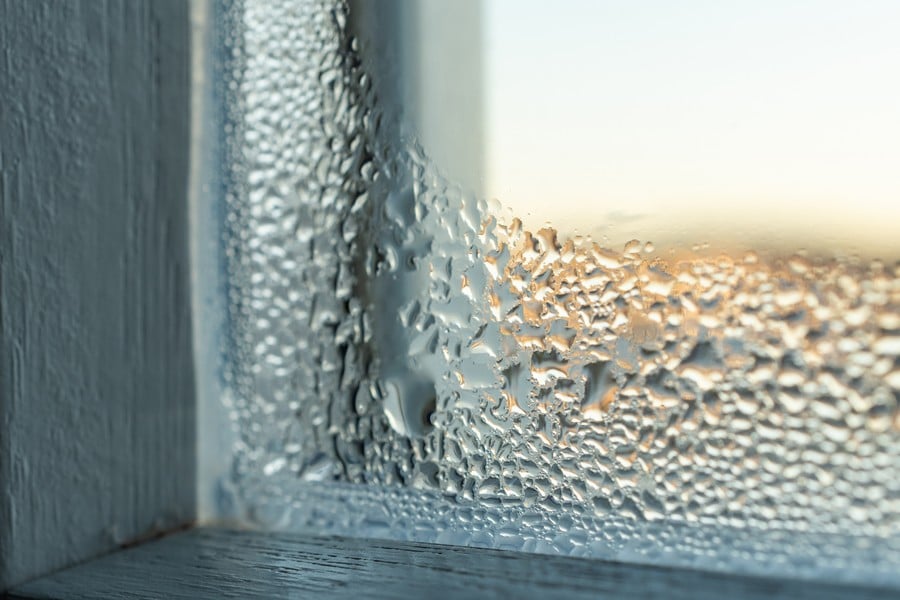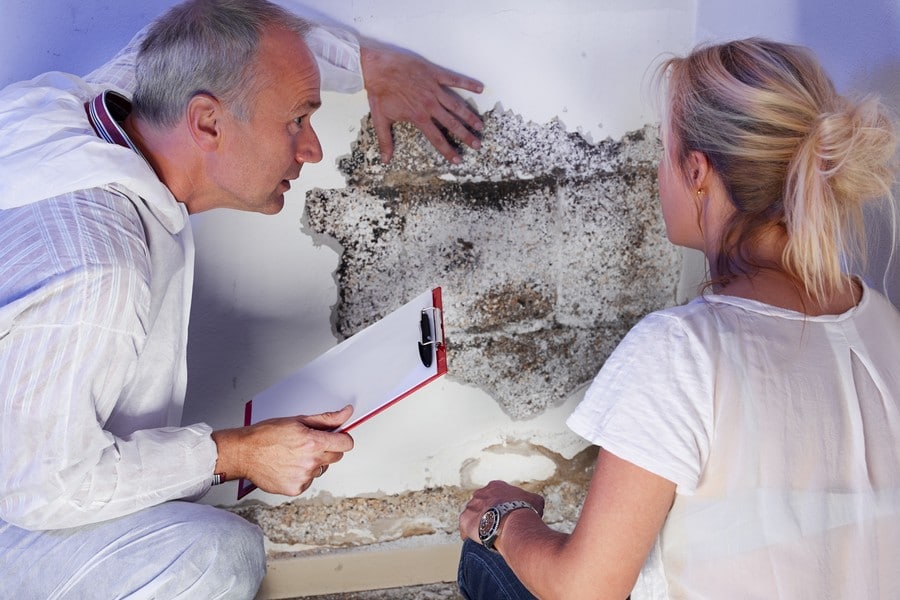Contact Sussex Damp Experts Now to Speak With an Expert.

Water seeping through the fabric of walls or rising from the ground beneath them can cause dampness in your walls. Capillary force, which draws water through tiny holes in brick or stone, allows moisture to travel upwards until gravity counteracts its upward movement. The maximum height for this capillary action is typically 1.2m. However, non-breathing wall coverings such as renders, vinyl wallpaper and paints can exacerbate the effects of dampness higher up on walls. Unlike penetrating damp that occurs due to rain penetration on top of walls or ceilings, rising damp arises from water ingress at ground level or below it.
To summarise: Rising damp is caused by water travelling upwards through tiny apertures in bricks and stones via capillary force before being stopped by gravity’s downward pull. Non-breathing wall coverings like renders and vinyl wallpapers can worsen the situation by allowing moisture to rise higher than usual levels (1.2m). This type of damp differs from penetrating damp which results from rainwater entering homes via roofs or ceilings rather than coming up from underneath floors where it causes damage over time if left untreated.
Distinguishing between increasing damp and condensation effects is crucial to addressing the problem correctly. While surface condensation may resemble growing dampness, certain indicators can help differentiate between the two. Masonry sampling, particularly of mortar, is a reliable technique for identifying rising damp. Examining wall conditions from within can also reveal whether your home is affected by this issue or not. Evidence of water penetration in samples indicates an increasing damp problem, whereas condensation does not produce such results. A Damp Proof Course (DPC) treatment option exists for rising dampness but must be applied correctly; otherwise, it will fail to address the issue at hand. Misdiagnosis leads to incorrect solutions that do not solve the underlying problem effectively.

Before addressing excessive moisture in a wall, it is crucial to determine the root cause. It could be due to increasing dampness or other factors such as condensation or rain penetration. To investigate growing dampness, one must first eliminate other sources of water infiltration, particularly during colder months when condensation can occur. A thorough examination should always be conducted to identify any additional sources of water intrusion that may interfere with identifying growing dampness accurately.
During the survey, all possible areas of moisture must be recorded and examined thoroughly for signs of decay and deterioration. Moisture indicators throughout the survey should also be recognised carefully. When there are multiple sources of water entry, it might be challenging to distinguish between them.
Active rising dampness can often be identified by excessive wetness at the base of a wall that gradually decreases as it rises up to 1.5 metres high (or more depending on circumstances). A ‘tidemark’ may also appear almost horizontally along the wall below which is clearly moist. It’s essential to specify the type and origins of any damp issue since this will affect treatment options and course-of-action needed; for example, Damp Proof Course (DPC) is not suitable for treating wet rot problems but only effective against rising damp issues.

It is imperative to remain vigilant for signs of increasing humidity on walls. These symptoms can indicate a potential problem that should be addressed promptly to prevent further expenses and disturbance to the building’s occupants. Regular inspections are recommended to detect any issues early on, allowing them to be resolved before they escalate into more significant problems. By taking swift action, you can avoid costly repairs and ensure the comfort and safety of those residing in the building. It is essential not to overlook these warning signs as they may lead to severe structural damage if left unattended.
Telltale signs of dampness in a building can be identified by the tide markings left on walls. These markings are caused by salt in the earth and evaporation, which produce visible tidal lines that may extend up to 1m above the skirting board. In addition to these marks, wet spots or stains on walls could also indicate dampness. Typically, such areas appear brown or yellow and resemble tide markings. These indicators can also be observed above the skirting board. It is essential to identify these signs early as they could lead to severe structural damage if left untreated for an extended period.
Inspect the area where the skirting board meets the wall for any signs of fungal growth or moisture creeping out. The presence of dampness can lead to timber damage and affect nearby objects, just like other forms of dampness. Be vigilant for flaking or chipped paint as it may indicate a deeper issue. If the problem seems to be limited only to the upper levels of the building, it is likely that penetrating damp is at play instead. It is crucial to address these issues promptly as they can cause significant structural damage if left untreated.
One of the telltale signs of dampness in your walls is the presence of salt deposits, which can take on a fluffy white appearance. These deposits are often caused by salts being washed out from within the brick and into the plaster, resulting in blistering patches on your walls. It’s important to address this issue promptly as it can lead to further damage if left unchecked.
The presence of black mould on your skirting board is a tell-tale sign that there may be an underlying moisture issue in the area. If this is the only instance of black mould in your home and it appears to be localised from the skirting board up to 1 metre above, it could indicate increasing dampness. It’s important to address this issue promptly as prolonged exposure to black mould can lead to health problems such as respiratory issues, allergies, and even neurological symptoms.
If you notice your wallpaper peeling away from the skirting board and curling up at the corner, it could be a sign of rising damp. This occurs when moisture seeps through walls or floors and causes damage to the structure of a building. It is important to address this issue promptly as it can lead to further damage such as mould growth and structural instability. Seeking professional help from a reputable company like Sussex Damp Treatments can provide effective solutions for rising damp problems. Don’t ignore any signs of rising damp in your home; take action immediately to prevent further damage and ensure the safety of your property.
To identify growing moisture, run your fingertips over the affected area and check for hard salts. Inspect exposed surfaces of stones or brickwork to see if they are moist or developing salts beneath the paint. Keep in mind that dampness typically occurs on ground floor levels due to moisture from the earth pushing up against walls. However, there are various types of dampness one should be aware of. For more information, visit our website. If you notice any clear signs of growing dampness, it is crucial to conduct a survey to investigate further before the issue worsens and causes damage to your building’s structure.
Contact Sussex Damp Experts Now to Speak With an Expert.
Sussex Damp Treatments offers specialised surveys to address the issue of rising damp caused by the absence or damage of a damp-proof membrane, as well as bridging, breakdown, or lack of physical damp. Our comprehensive surveys and solutions cater to wet concrete floors and growing dampness, ensuring that your home is free from increasing levels of moisture. With our expert assistance, you can effectively eliminate any signs of rising damp in your property.
Our team of certified and highly trained surveyors will conduct a thorough examination of your increasing damp problem, determining the source and origin of the wetness. We ensure that no objects are missing in the impacted or at-risk region while viewing various types of dampness and treatment options available for your home. Our experts look for any symptoms indicating a problem with wood, finding the finest rising damp solution within your budget and requirements. Within XX hours, we provide you with a comprehensive survey report detailing our findings. If additional actions to protect your property are necessary, we offer advice on how best to proceed. Contact Sussex Damp Treatments today for a quote, consultation, and expert advice by calling 01273 257 212. Trust us to handle all aspects of your damp issue with professionalism and expertise.
When used correctly, a surface electrical moisture metre can serve as a valuable indicator of the presence of growing dampness. However, it cannot provide absolute confirmation, particularly if remedial work has already been carried out. It is important to note that this tool should be utilised in conjunction with other methods for detecting and diagnosing damp issues within a property. While it may not provide definitive proof on its own, it can still offer useful insights into potential problems that require further investigation by qualified professionals. Therefore, relying solely on the results from an electrical moisture metre could lead to inaccurate conclusions and ineffective solutions. A comprehensive approach involving multiple diagnostic tools and expert analysis is necessary for accurately identifying and addressing any underlying dampness complex issues within a property.
Accurate evaluation of potential rising dampness requires quantitative moisture measurements, which can be achieved through specific procedures. The process involves drilling a vertical sequence of samples and measuring the hygroscopic and capillary moisture content in each sample. Capillary moisture content reflects water intrusion, making it possible to determine the presence or absence of rising dampness by examining its distribution in the vertical profile. This method is also effective at detecting issues caused by hygroscopic salt contamination rather than water penetration. By conducting these precise measurements, we can confidently diagnose any moisture-related problems affecting your property and take appropriate measures to address them promptly.

Contact Sussex Damp Experts Now to Speak With an Expert.
Without a doubt, the answer is affirmative. The escalating humidity levels can cause significant health concerns for all occupants of a dwelling. This issue becomes more pronounced in individuals with pre-existing respiratory ailments and other related conditions.
The cost of a damp and timber survey may vary depending on the size of the structure and how quickly you detect growing damp. However, investing in this type of examination can save you money in the long run by preventing property damage. It is accessible to all homeowners who want to ensure their properties are free from moisture-related issues that could lead to structural problems or health hazards. Not only does it provide peace of mind, but it also helps identify any underlying issues before they become more severe and costly to repair. By taking proactive measures through regular inspections, you can maintain your home’s value while protecting your family’s health and well-being.
Call Our Sussex Damp Experts team now for a free quote, consultation and advice:
Our team of seasoned professionals will conduct a thorough analysis and precise diagnosis of the extent of your rising damp issue. Based on our findings, we will recommend specific damp treatments and employ the most effective techniques to address your condition. Our experts are trained to exceed industry standards, with our surveyors holding certification as Certified Surveyors in Remedial Treatment (CSRT). This accreditation ensures that we provide unparalleled care and priority to all our customers, delivering exceptional results every time.
Schedule a comprehensive survey to assess rising dampness in your property by making an appointment or contacting us directly. Our team of skilled and experienced damp surveyors is available to visit your home at a time that suits you best. We understand the importance of swift action, which is why we prioritise scheduling visits promptly. Rest assured that our local teams are equipped with the necessary tools and expertise to provide accurate assessments and recommend effective solutions for any issues identified during the survey. Don’t hesitate to get in touch with us today for professional assistance in addressing rising dampness concerns in your property.


Max and his team have been at our property all week and I really can’t thank them enough for the fantastic job they’ve done on plastering both our walls and ceilings. They have literally transformed the appearance of our house! Not only has Ma…
From start to finish Max has been incredable. His knowledge lin damp proofing is second to none and his team where very clean and polite. The plastered finish was like glass so happy we choose Max Plastering for job.
Lovely bunch of lads left a very neat and clean job. Problem was solved.
Perfect Finnish and all left clean and tidy and no mess. Used Max previously and would not hesitate to ask him carry out more work.
Max, Harvey and Stuart arrived promptly as arranged. Done a great job on our outside rear wall. Work completed to a high standard, removal of all old material and cleaned up after themselves. I am so pleased with the standard of their work they ar…
They turned up on time and carried out the works in a very professional manor leaving the front of the house clean and tidy. Very impressed would definitely recommend.
I have to say that on every level Max (with Stuart and Harvey) did an extremely professional job! They explained what they were going to do, they were polite and courteous and respected that they were coming into our home. The plastering is of the…

I called max and he managed to come around the same day to do a survey. The next day I received an extremely detailed survey compared to any other damp proofer which made me feel very at ease that he was going to do the right job. Max and team tur…
Contact Sussex Damp Experts Now to Speak With an Expert.